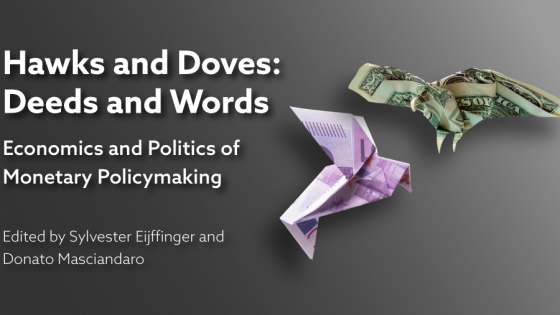The role of the monetary policy decisions in influencing markets and economies has increased sharply over the past 30 years, mainly driven by the recommendations of economic theory and the efforts of policymakers to improve central banking institutions. Two recent evolutions in the research on monetary policy decisions is the analysis of the mechanisms that govern the production and distribution of such decisions, i.e. the fields of monetary policy governance and monetary policy communication. Deeds and words are two sides of the same coin, and economics and politics the two crucial lenses through which this special coin have been evaluated.
The aim of a new VoxEU eBook (Eijffinger and Masciandaro 2018) is to present the state of art of the economics and politics of modern monetary policy governance as a story of two tales which are both parallel and intertwined: on the one side, the tale of how monetary policy decisions are reached; on the other side, the tale of how such decisions can influence the shape of the markets via central banks’ communication policies.
Download the new eBook here:
Hawks and doves
On the one side of the coin, the monetary policy setting has been characterised by the widespread establishment of monetary policy committees (MPCs), a process which started in the late 1990s (Fry et al. 2000, Lybek and Morris 2004). The issue of MPCs is related to various dimensions of monetary policymaking (Chappell and McGregor 1993, Blinder and Morgan 2005 and 2008, Besley et al. 2008, Jung 2013), concerning preferences and information on the one honad (Eijffinger et al. 2013, 2015), and voting procedures (Dal Bo 2006, Riboni and Ruge-Murcia 2010) on the other. Recently one more aspect that has been integrated in MPC decisions is behavioral economics (Favaretto and Masciandaro 2016).
On the other side of the coin, there has been evidence of the growing importance of the links between monetary policy decisions and communication in influencing the overall effectiveness of monetary action in the modern economies.
Up to the 1980s, central banks were very much shrouded in monetary mystique and secrecy (Goodfriend 1986). The theoretical rationale for the lack of monetary policy transparency and communication was given by the theory of ambiguity, credibility, and inflation under discretion and asymmetric information developed in the seminal article by Cukierman and Meltzer (1986).
Later on, the development of the modern theory of monetary policy – based on the intertwined concepts of rules in policy on the one side (Taylor, 1993, Walsh, 1995) and independence and accountability of the policymaker on the other (Eijffinger and Masciandaro 2014) – naturally produced a change in communication prescriptions from secrecy to transparency. Discretion and ambiguity in monetary policy were abandoned in favour of monetary policy rules that were explicitly announced and motivated. Transparency became a key feature of the central banking setting (Eijffinger and Geraats 2006).
It has increasingly been stressed that the effectiveness of central banks in affecting the economy critically depends upon their ability to influence market expectations regarding the future path of monetary policy decisions, and not merely their current stance. The public’s understanding of current and future policy therefore becomes critical for the success of policy. In other words, monetary policy increasingly became the art of managing expectations via effective communication strategies (Issing 2005, de Haan et al. 2007, Blinder et al. 2008).
Deeds
The first part of the eBook explores the relationships between central bank governance and monetary policy in the aftermath of the Global Crisis. Up to 30 years ago, economic theory did not attribute importance to the concept of central bank governance. Institutional arrangements became important when the economic theory started to stress their role in determining the macroeconomic performances during the New Classical Revolution. The role of the central bank design and governance was then confirmed in the New Keynesian analysis of monetary policy, and in the mainstream a consensus was reached on the identification of optimal central bank governance.
Optimal central bank governance also essentially has to be a coin with two sides. On the one side, the central banker has to be independent – i.e. the central bank should enjoy the ability to implement non-inflationary monetary policy without any external (political) short-sighted interference. The central banker becomes a veto player against inflationary monetary policies. On the other side, the central banker has to be conservative, where conservatism refers to the importance that he/she assigns to price stability in its relation to other macroeconomic objectives. Conservatism is the necessary step to avoid the central banker himself/herself becoming a source of macroeconomic distortions. Independence and conservatism become the conditions to implement credible non-inflationary monetary policies.
In addition, a conservative central banker is credible if he/she works in an institutional setting that guarantees independence and accountability, acting in a transparent way and implementing an effective communication policy. The relationship between independence and accountability came to represent the core of central bank governance.
Central bank governance became the institutional setting for implementing day-to-day monetary policy, which in turn represented the final outcome of the interaction between three main pillars: monetary institutions, central banker preferences, and policy choices.
But then the Global Crisis came along, and today the crucial question is how the three pillars can be affected. The eBook addresses this question, tackling in sequence the three different, but intertwined, issues.
Words
The second part of the eBook sheds light on the evolution of central bank communication as well as on the growing importance of such communication in influencing the overall effectiveness of monetary policy action.
During the 1970s and 1980s, mystique and secrecy characterised central banks’ actions. The theoretical rationale for the lack of central bank transparency and communication was given by the theory of ambiguity, credibility and inflation under discretion and asymmetric information.
Then transparency of central bank decision making has increased rapidly from the early 1990s, beginning with the adoption of inflation targeting by the Bank of England, the Bank of Canada, the Reserve Bank of New Zealand, and the Swedish Riksbank. Although the Federal Reserve System was officially not conducting inflation targeting, in practice it gradually shifted more or less to inflation targeting. From its beginning, the ECB adopted a so-called two-pillar strategy, with a monetary pillar focusing on monetary aggregates like M3 (which it inherited from the Deutsche Bundesbank) and an economic pillar taking account of the drivers of inflationary expectations. However, since the Global Crisis the ECB has moved closer and closer to inflation targeting in practice.
Most central banks have put an increasing and larger weight on their communication with the public. An important trigger for increased transparency has been the requirement for greater accountability of independent central banks. As central banks have become more independent over time, they have to pay closer attention to explaining what they do and what underlies their decisions. More transparency and increased use of communication is in part a logical consequence of this development.
During the Global Crisis, central banks stepped up their communication activities even more. In particular, once central banks had resorted to unconventional policies, they went to great efforts to publicly define the scope and implementation of these policies, as well as to build a common understanding of their limitations and their expected effectiveness. In addition, many central banks became more explicit in signalling the direction of their policies through various forms of forward guidance – at which point, communication reached the status of an explicit policy tool.
The rising economic uncertainty caused by the crisis and the use of new tools increased complexity for policymaking. This was accompanied by an increasing tendency for central bank committee members to disagree and a substantial increase in the length of the minutes of central bank committee meetings. This increasing complexity was also reflected in central banks’ monetary policy statements. Here, the interactions between the first and second part of the eBook emerge even more clearly.
The difficulty for markets is that central bank communication typically provides multidimensional information, which makes it hard to decipher all signals clearly. The current and future challenge for central banks is to ensure that they send signals as clearly as possible. It will be not easy.
References
Besley, T, N Meads and P Surico (2008), “Insiders versus outsiders in monetary policymaking”, The American Economic Review 98(2): 218-223.
Blinder, A, M Ehrmann, M Fratzscher, J De Haan and D J Jansen (2008), “Central Bank Communication and Monetary Policy: A Survey of Theory and Evidence”, Journal of Economic Literature 46(4): 910-945.
Blinder, A S and J Morgan (2005), ”Are two heads better than one? Monetary policy by committee”, Journal of Money, Credit and Banking 37(5): 789-811.
Blinder, A S and J Morgan (2008), ”Do monetary policy committees need leaders? A report on an experiment”, The American Economic Review 98(2): 224-229.
Briault, C B, A G Haldane and M A King (1996), “Central Bank Independence and Accountability: Theory and Evidence”, Bank of England Working Paper Series No. 49.
Chappell, Jr, H W M and R R McGregor (1993), “Partisan monetary policies: Presidential influence through the power of appointment”, The Quarterly Journal of Economics 108(1): 185-218.
Cukierman, A and A Meltzer (1986), “A Theory of Ambiguity, Credibility and Inflation under Discretion and Asymmetric Information”, Econometrica 54(4): 1099-1128.
Dal Bo, E (2006), “Committees with Super Majority Voting yield Commitment with Flexibility”, Journal of Public Economics 90(4): 573-599.
de Haan, J, S C W Eijffinger and K Rybinski (eds) (2007), “Special Issue: Central Bank Transparency and Central Bank Communication”, European Journal of Political Economy 23.
Eijffinger, S C W and D Masciandaro (eds) (2014), Modern Monetary Policy and Central Bank Governance, Edward Elgar Publishing.
Eijffinger, S C W and D Masciandaro (eds) (2018), Hawks and Doves: Deeds and Words - Economics and Politics of Monetary Policymaking, A VoxEU eBook.
Eijffinger, S C W and P Geraats (2006), “How Transparent Are Central Banks”, European Journal of Political Economy 22: 1-21.
Eijffinger, S C W, R Mahieu and L Raes (2013), “Inferring Hawks and Doves from Voting Records”, CEPR Discussion Paper No. 9418.
Eijffinger, S C W, R Mahieu and L Raes. (2015), “Hawks and Doves in the FOMC”, CEPR Discussion Paper No. 10442.Favaretto F and D Masciandaro (2016), “Doves, Hawks and Pigeons: Behavioural Monetary Policy and Interest Rate Inertia”, Journal of Financial Stability 27: 50-58.
Fry, M, D Julius, L Mahadeva, S Roger and G Sterne (2000), “Key Issues in the Choice of Monetary Policy Framework”, in L Mahadeva and G Sterne (eds), Monetary Policy Frameworks in a Global Context, Routledge.
Goodfriend, M (1986), “Monetary Mystique: Secrecy and Central Banking”, Journal of Monetary Economics 17(1): 63-92.
Issing, O (2005), “Communication, Transparency, Accountability: Monetary Policy in the Twenty-First Century”, Federal Reserve Bank of Saint Louis Quarterly Review 87(2): 65-83.
Jung A (2013), “Policy Makers Interest Rates Preferences: Recent Evidence on for Three Monetary Policy Committees”, International Journal of Central Banking 9(3): 45-192.
Lybek, T and J Morris (2004), “Central Bank Governance: A Survey of Boards and Management”, IMF Working Paper No. 226.
Riboni A and F J Ruge-Murcia (2010), “Monetary Policy by Committee: Consensus, Chairman Dominance, or Simple Majority?”, Quarterly Journal of Economics 125(1): 363-416.
Taylor, J B (1993), “Discretion versus Policy Rules in Practice”, Carnegie – Rochester Series on Public Policy 39: 195-214.
Walsh, C (1995), “Optimal Contracts for Central Bankers”, American Economic Review 85: 150-176.



